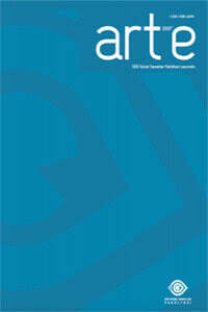Lynd Ward ve Ağaç Baskı Romanı Vertıgo
Lynd Ward And Hıs Woodcut Novel Vertıgo
Lynd Ward, Woodcut Novel, Wordless Novel Vertigo,
___
- Beronä, D. (2003). "Wordless Novels in Woodcuts". Print Quarterly, Cilt 20, Sayı 1, 61–73.
- Beronä, D. (2008). Wordless Books: The Original Graphic Novels, New York: Abrams Books.
- Beronä, D. (2009). "Introduction", Vertigo: A Novel in Woodcuts, New York: Dover Publications, s. v–ix.
- Cohen, M. (1977). “The Novel in Woodcuts: A Handbook”. Journal of Modern Literature, Cilt 6, Sayı 2, s.171-195.
- Eisner, W. (1996). Graphic Storytelling and Visual Narrative, Tamarac: Poorhouse Press.
- Herb, S. (2012). http://voicesweb.org/lynd-ward-art Erişim tarihi: 30.09.2017.
- Herb, S. (2016). “The Continuing Influence of Graphic Novelist and Children’s Book Illustrator: Lynd Ward”, Frontiers in American Children’s Literature, ed. Dorothy Clark ve Linda Salem, s. 207-228.
- Mattingly, P. H. (2001). Suburban Landscapes: Culture and Politics in a New York Metropolitan Community, Baltimore: John Hopkins University Press.
- Pitz, H. C. (1955). “The Illustrations of Lynd Ward”. American Artist, Cilt 19, Sayı 3, Mart, s. 32-37.
- Spiegelman, A. (2010). "Reading Pictures", Lynd Ward: God's Man, Madman's Drum, Wild Pilgrimage içinde, ed. Art Spiegelman, New York: Library of America, s. ix–xxv.
- Ward, L. (1974). Storyteller Without Words: The Wood Engravings of Lynd Ward with Text by the Artist, New York: Harry N Abrams Inc.
- Willett, P. (2005). “The Cutting Edge of German Expressionism: The Woodcut Novel of Frans Masereel and Its Influences”, A Companion to the Literature of German Expressionism, der. Neill H. Donahue, New York: Camden House, s. 111-134.
- Yayın Aralığı: Yılda 2 Sayı
- Başlangıç: 2008
- Yayıncı: Süleyman Demirel Üniversitesi Güzel Sanatlar Fakültesi
İcadından Günümüze Portre Fotoğrafında “Yerel ve Global” Kimlik Kurgusu
Ahmet BEYHAN ÖZDEMİR, Pınar BOZTEPE MUTLU
Kahramanmaraş Gelenekli İğne İşi Motiflerinin Modern Yaklaşımla Tekstil Yüzeylerine Uygulanması
Sorumluluk Kavramı Üzerinden Görsel İletişim Tasarımında Etik ve Eğitimi
Deneysel Bir Yaklaşım Olarak Kolaj ve Karışık Teknik Uygulamasının Fotoğraf Sanatına Yansıması
Alanya Geleneksel Tophane Evlerinin Cephelerinde Mimari Eleman ve Malzemenin Dönüşümü
J. S. Bach’ın Bwv 881 Fa Minör Prelüd ve Fügünün Analizi ve Eğitsel Açıdan Öneriler
Rasim Erol Demirbatır, Nilüfer ÖZER
Foucault’nun İktidar Kavramı Odağında Distopik Kurgular ve Sam Shepard’ın Görünmeyen El’i
Oyunculukta Karakter Yaratma Yaklaşımları Üzerine Bir İnceleme
Yüzüklerin Efendisi’ndeki Karakterlerin Arketipsel Nitelikleri ve Kostüm Tasarımına Etkisi
